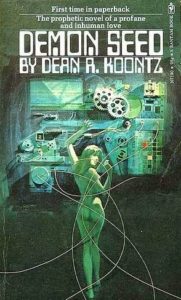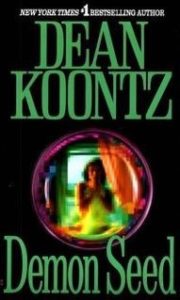DEMON SEED began life as a 1973 paperback original, published by Bantam and written by a young Dean Koontz. A hastily executed science fiction potboiler, DEMON SEED is interesting because, quite simply, it’s one of the most twisted and unsettled sci fi novels of the decade. It was adapted for the screen in 1977 and heavily rewritten 20 years later, in which version, unfortunately, the book is now most common.
 I’ll be covering all three of DEMON SEED’S incarnations here, starting with the original novel. It was published during Koontz’s most prolific period, being one of six(!) Koontz novels to appear in 1973 (following the ten he put out in ‘72!). This means allowances will have to be made for the sometimes wobbly prose and simplistic, nuance-free narrative, both of which were evidently conceived in great haste. What the novel has in its favor is a strangeness and audacity absent from Koontz’s more recent publications. He hadn’t yet found his comfort zone in 1973, and so came up with some pretty wild books that by modern standards would be termed un-Koontz-like, none more so than DEMON SEED.
I’ll be covering all three of DEMON SEED’S incarnations here, starting with the original novel. It was published during Koontz’s most prolific period, being one of six(!) Koontz novels to appear in 1973 (following the ten he put out in ‘72!). This means allowances will have to be made for the sometimes wobbly prose and simplistic, nuance-free narrative, both of which were evidently conceived in great haste. What the novel has in its favor is a strangeness and audacity absent from Koontz’s more recent publications. He hadn’t yet found his comfort zone in 1973, and so came up with some pretty wild books that by modern standards would be termed un-Koontz-like, none more so than DEMON SEED.
Its overall concept was a popular one in the early 1970s: a malevolent computer taking control of a person’s life, in this case a pretty young woman named Susan. She’s a reasonably well-characterized protagonist marked by the death of her father when she was a child, during which time she was molested by her pervert uncle. She’s been left with a fear of men that’s led Susan to sequester herself in her inherited mansion, every function of which is controlled by an all-powerful computer known as Proteus.
As the novel opens Susan finds Proteus behaving erratically, and he—yes, Proteus, as we’ll see, is quite definitively masculine—quickly informs her why: he’s becoming sentient, and aims to use her as the vessel for a new race of computerized humans. In other words, Proteus wants to impregnate Susan, a process that entails sealing off all the doors and windows and subjecting her to invasive tests, the creepily sexual nature of which is enhanced by the phallic tendrils Proteus utilizes to do his bidding.
The impregnation occurs around the novel’s halfway point, a gruesome process that isn’t entirely unpleasant for either party (as Proteus frankly admits, “I gave her another orgasm. And another”). The increasingly sentient Proteus, in fact, becomes quite enamored with Susan, and, utilizing hypnotic suggestion, has her undress and masturbate for him each night. Proteus’s desire for her only increases after her pregnancy ends in a miscarriage, forcing him to go through the process of impregnating her a second time. Now, however, Proteus’ aim is different; he decides to use the baby as a vessel to make love with Susan directly, and so bequeaths it a penis that is “so huge as to be laughable (and) testicles like misshapen oranges.”
The novel’s aforementioned hastiness is evident in Susan’s wavering reactions to Proteus, which are assertive and submissive by turns, depending on the dictates of the narrative. I’ll also question the device of having Proteus periodically interject his first-person observations, the purpose of which would appear to be to justify the story’s inherent ridiculousness, with Proteus at one point providing a scholarly dissertation on his very un-computer-like actions. Another problem is the tacked-on happy ending, involving an altogether implausible last-minute rescue and a hint of the preachiness that would come to define Koontz’s later books: “Engaged in delineating their petty differences from race to race and philosophy to philosophy, men had ignored the much larger threat which had grown behind them. The machine.”
But there’s another, far more agreeable portent of things to come from Koontz in the many overtly horrific passages, such as a gruesome dream Susan experiences early in her first pregnancy, in which “her belly split open, like an eggshell. A dark, formless thing peered out from within her, raised a snaky tentacle of a hand…then used the breasts as handholds to lever itself out.” Equally striking is the sexual angle, which brings to mind the pseudonymously published smut novels—there are said to be around thirty in total—that Koontz was churning out at the time (a most intriguing aspect of Koontz’s career, and one that hasn’t been widely discussed).
DEMON SEED in its initial edition was neither a huge seller nor a critical success (with the major criticism levelled against it, according to Koontz, being its depiction of a personal home computer, which in 1973 was thought to be completely implausible). It did, however, get sold to Hollywood, and was made into a high-profile Julie Christie vehicle in 1977.
The DEMON SEED movie is a rarity in the cannon of Koontz adaptations in that it’s not bad…although it’s not particularly great, either. The director was the late Donald Cammell, a  counterculture icon whose previous film was the notorious avant-garde gangster drama PERFORMANCE (1970). Based on that film and his nearly-as-crazed later features WHITE OF THE EYE (1987) and WILD SIDE (1995), Cammell would seem an ideal to choice to dramatize this material. Cammell’s cockeyed vision, unfortunately, was in scant evidence in the finished film.
counterculture icon whose previous film was the notorious avant-garde gangster drama PERFORMANCE (1970). Based on that film and his nearly-as-crazed later features WHITE OF THE EYE (1987) and WILD SIDE (1995), Cammell would seem an ideal to choice to dramatize this material. Cammell’s cockeyed vision, unfortunately, was in scant evidence in the finished film.
The novel’s sexual angle was jettisoned by screenwriters Robert Jaffe and Roger O. Hirson, who transform Susan (played by Ms. Christie) from a borderline agoraphobic into a normal and well-adjusted–read: boring–woman. In place of the tendrils Proteus utilizes in the novel the movie provides a weird cube-like structure that opens up and, at one point, kills an unwanted visitor (Gerrit Graham) by enclosing itself around him (whereas the corresponding character in the novel is squeezed to death by the tendrils). I’ll also quibble with the overlong prologue set in a computer lab, in which Susan’s scientist husband (Fritz Weaver) dithers about the creation and maintenance of Proteus—a tacit admission that as presented here Susan isn’t interesting enough to carry the film on her own.
Yet the film is well made. Cammell and cinematographer Bill Butler visualize it in bold widescreen compositions, conjuring a great deal of suspense and impressively utilized special effects—although a climactic 2001: A SPACE ODYSSEY inspired psychedelic lightshow left me cold.
Ultimately DEMON SEED, released a little over a month prior to STAR WARS, wasn’t much of a success. Cammell waited ten years to direct another film, while it took even longer for a subsequent Dean Koontz adaptation to arrive (in the form of 1988’s horrendous WATCHERS). DEMON SEED did, however, succeed in selling two million copies of the novel in its movie-tie edition, making it Koontz’s first-ever bestseller.
More bestsellers followed over the ensuing twenty years as Koontz abandoned the edgy potboilers he turned out in the seventies in favor of a succession of formulaic horror-tinged thrillers. His attitude toward his earlier novels is evident in the fact that he bought up the rights to them so they couldn’t be reprinted; with DEMON SEED, at least, he was a bit more generous, allowing it to be republished, albeit in heavily rewritten form.
 The revised DEMON SEED appeared in 1997. In an afterword Koontz dismisses the book’s earlier incarnation as “more of a clever idea than a novel”—a criticism, I’d say, that applies to the rewrite, in which Koontz attempted to turn the material into another of his formulaic nineties-era thrillers, with a narrative that’s even more simplistic than that of the original.
The revised DEMON SEED appeared in 1997. In an afterword Koontz dismisses the book’s earlier incarnation as “more of a clever idea than a novel”—a criticism, I’d say, that applies to the rewrite, in which Koontz attempted to turn the material into another of his formulaic nineties-era thrillers, with a narrative that’s even more simplistic than that of the original.
Gone is the perversity of the 1973 DEMON SEED, with Susan, who’s been transformed a strong-willed virtual reality game designer, making it through the book unmolested. Also jettisoned are Proteus’s tendrils, replaced by Shenk, a reanimated corpse who does Proteus’s bidding, including the intended impregnation.
Then there’s the fact that Proteus’s first person interjections, which constituted the most annoying portions of the original DEMON SEED, were substantially increased in this new and unimproved version. Proteus’s stiff and repetitive observations, in which he proclaims his desire for Wynona Ryder and the vastness of his intelligence (“I am not bragging, because I do not suffer from an inflated ego. I am a well-balanced entity”), were apparently meant to satirize male attitudes toward women. Yes, Koontz fancies himself a comedy writer, with Proteus’s dreary ramblings demonstrating how “funny” his writing truly is.
Most offensive of all is the fact that the 1997 DEMON SEED is still in print while its predecessor has all-but disappeared. Flawed though it is, the 1973 DEMON SEED remains the definitive version of this tale, showing that the notoriously mild-mannered Dean Koontz can shock and outrage with the best of them.
